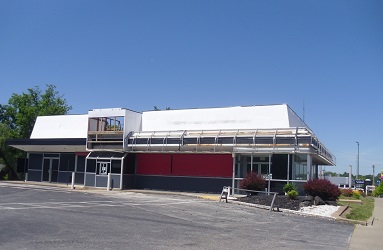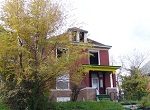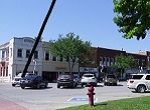Recycling Buildings Through Re-Use Makes Great Spaces
Last Reviewed: May 23, 2024
Recycling buildings into a new use or configuration can make them viable contributors to the local economy again. Sometimes a building that is a candidate for what is known as adaptive reuse, where the land use is actually changed, is an older building that could add neighborhood character or quirkiness if refurbished and made functional for today's society, without changing the land use. On this page though we're concentrating on simply finding another tenant without drastic change in the use of the building.
 When a vacant restaurant becomes another restaurant, that's recycling a building.
When a vacant restaurant becomes another restaurant, that's recycling a building.Building re-use also prevents demolition, which is costly to the environment from the standpoint of the energy used and the amount of debris that usually is buried in the landfill.
There's even an idea that buildings represent already embodied energy, whereas new construction certainly will require more energy than renovating a structure for a new occupant.
Determining Which Buildings to Recycle
The first step in recycling buildings will be to inventory vacant buildings that should be saved. You could ask yourselves the following questions.
1. Is the amount of money necessary to return this building to productivity likely to be repaid within a reasonable time?
2. Is the building structure and layout on the lot fundamentally sound?
3. Is the architecture suitable for the neighborhood? If the building is lacking in architectural character, can some details be added? If the architecture is not sympathetic to the prevailing style, can an imaginative way to make it more compatible with the neighborhood be devised?
4. Does the amount of space and placement of the building on the lot lead to the reasonable conclusion that a tenant or new owner can be found?
5. Being strictly honest with yourselves, does the demand for the previous use still exist? If the previous type of business is rapidly being obsolete because of changing tastes, automation, offshore outsourcing, or online procurement of goods and services, checking into adaptive reuse may be your best bet.
6. Can your community find a real estate developer or contractor capable of the work involved?
7. Does the building in question have either architectural merit or historical significance for your community? If so, your potential for a recycled building just jumped. Note that the question of historical value can become contentious, but you should focus on local history, not a national or international storyline. For example, see our answer to a site visitor question they entitled old building needs love.
8. Is there a community organization or even a local government that will help oversee the project and market the space? This is especially vital if the owner or building contractor isn't experienced in real estate development or can't devote full time to oversight. Many times an owner thinks they are a developer, but their interests do not align with those of the neighborhood or municipality, so in the best projects, often both of these become involved in influencing the developer.
Working with Professionals on Recycling Buildings
Depending on the size of your building or buildings, your community may be embarking on a major redevelopment project, or you may even have what is known as a brownfield site, which is a site that is perceived to be or actually contaminated environmentally in some way.
If you have a major project, it's best to find an architect to work with you, and certainly if there is re-design, an addition, moving of load-bearing walls, or structural damage or collapse, you'll need a structural engineer. You also might need a civil engineer if you need parking lot design, pedestrian bridges, and such. Usually you'll need a developer or versatile general contractor.
You, the building owner, a community group, or professionals also must supply the vision. If you don’t have one, you might need to hire a city planning consultant.
You may need a market analysis if you propose to change the use of the building. There are economics research firms and consultants that do this type of work. (Changing the use to a purpose more in demand in today's economy is known as "adaptive re-use" among professionals.)
Sometimes the market analysis is wrong, or sometimes you won't need one if you already have a tenant or new owner identified. But if your community can afford it, the analysis is still a good idea.
The last thing you want is a vacant building again in a few years because someone was too idealistic about saving an old building or a newer commercial white elephant such as the bankrupt big box store or a 30-year-old chain restaurant with the too-distinctive architecture.
Recycling buildings can be hard work, as there is no one-size-fits-all approach to the work. There are no economies of scale, in contrast to building the same strip mall or subdivision house over and over again. However, the rewards can be really substantial. Before you say it can't be done, imagine many different solutions to making the space modern, viable, and lease-worthy.
When we say "modern," we don't mean stripping an old building with good bones of its distinctive trim, windows, and doors. Sometimes recycling buildings involves careful restoration using replicas of historic building elements when the originals are simply worn out. We do mean, however, that all functions expected for commercial or market viability are fulfilled, including heating, air conditioning, some measure of energy efficiency, and adequate plumbing and electrical systems for today's user.
All in all, recycling buildings is incredibly rewarding and can create some charming and unique spaces that build momentum for the economic development of the community.
Environmental benefits of re-use include waste reduction and a smaller community carbon footprint when compared to demolition followed by new construction.
Learn About these Related Topics
 Vacant Property Registration
Vacant Property Registration- Making and Keeping a Good Community >
- Community Challenges, Common Topics & Concepts >
- Redevelopment > Recycling Buildings
Join GOOD COMMUNITY PLUS, which provides you monthly with short features or tips about timely topics for neighborhoods, towns and cities, community organizations, and rural or small town environments. Unsubscribe any time. Give it a try.



